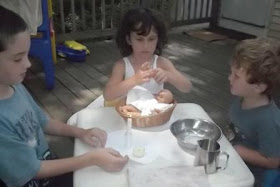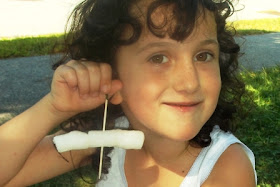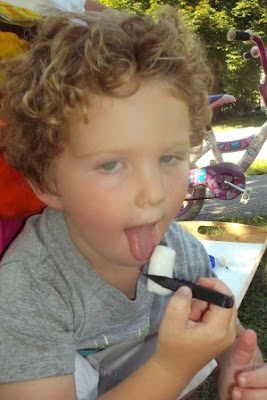When I was
a kid, I never liked geography or history very much. Such subjects were simply too dry for me – or
so I thought they were, because of the way they were introduced and taught to
me.
As an
adult, things have changed. My husband,
children and I love history and geography!
We read book after book about it and then find ourselves diving into
hands-on projects that our readings inspire.
So, when I was offered a chance to receive an e-copy of Knowledge Quest's A Child’s Geography: Explore the Classical
World by Terri Johnson in exchange for an honest, I jumped at the
chance.
I am glad I
did. For just this morning at breakfast
time, Luke asked, “Mom, can we read more of that history thing again?” Yep, he’s hooked and, I am confident that Nina
and Jack will get there, too.
A Child’s Geography: Explore the Classical
World is definitely going to be an integral part of our homeschool
endeavors this year. I’d recommend that
like-minded homeschoolers, after-schoolers and just folks who like history and
geography check it out, too. Keep on reading for a review and then two
giveaway options!
* * * * and ¾’s
A
* READABILITY
Imagine sailing away to the countries around the Mediterranean
with little clue about the region’s culture, food, landmarks, history and
terrain. You might enjoy yourself some,
but you’d likely feel a bit lost.
Now imagine
that as soon as you set foot in the first country, a woman walks up and offers
to show you around. She knows the ins
and outs of the place – both present and past – and happily chats with you
about them as she accompanies you on your journey. Wouldn’t that exponentially enrich your experience?
That is
what A
Child’s Geography, Vol. III, geared at grades 1 to 6, does for history and geography studies, in my
opinion, when compared to the way I was taught history growing up.
Truly, Luke,
Nina, Jack and I have been reading it, I have been thinking, “Wow! I wish my textbooks back in the day were this
conversational.” I am glad I can bring my children on a
virtual tour of the Classical World through the book’s conversational text and
well-chosen images. It is an easy,
informative and engaging read, and, as I mentioned earlier, has become a
requested-by-Luke one here.
A * RELEVENCE
Last spring,
we started dabbling with The Story of the World and related picture books, and, even
as my children dove into Egypt studies, Luke began asking when we might get to
explore Greece and Rome. So, I knew
before I even read A
Child’s Geography, Vol. III that it would be relevant reading for us this
year.
Before I
received the e-book and its accompanying materials, I did not know quite how
relevant it would be. I love the way the book ties history
together with modern times, taking us on a present-day voyage throughout 10 countries
around the Mediterranean, while weaving in
historical facts and myths. (My
children especially love the “stories” of the past!)
A
* PRACTICALITY
A
Child’s Geography, Vol. III is more than just a book. It is a self-standing history-geography curriculum that comes in the
form of a 224 full-color print or e-book, along with a CD-ROM3 or e-version of
bonus materials. Overall, it
includes:
- engaging,
conversational text and vivid full-color photos, in a “living book” style
-
narration prompts to help with narration and to cement learning
-
notebooking, timeline and mapping activities for context
-
helpful pronunciations and full definitions in glossary
-
ideas for supplementary activities that focus on art, music, poetry and the mouth-watering
food of each country (although, we cannot try most of that with our restricted
diet!)
-
an optional prayer walk for each country
So,
whether you’re a hands-on, experiential
sort of family, or one that just wants and open-and-go book curriculum, this
resource can work.
A
3/4* LONGEVITY
I want to
give A
Child’s Geography Volume III: Explore the Classical World a full star for
longevity, because I know my family will
use it this year with me reading it to the kids and that we will probably revisit
it least one or two more times in years to come, with the kids reading it to
one another, as we cycle through from ancient times to modern ones and back
again. However, I am also aware of
many wonderful history programs and some families need for change, so – being honest
– I would guess that some families might not get more than one year’s use out
of the materials. So, while I think that
year would be a completely enriched one, in deference to the fact that the
resource may only serve some families for a single year, I am subtracting a
portion of a star.
A * VALUE
Our family
has been enjoying A
Child’s Geography, Volume III: Explore
the Classical World and I honestly feel that even though we received it
free in exchange for an honest review that it would make a great buy for
others. For while living books from the library, internet searches and, yes,
even dry encyclopedias could provide similar information to the A Child’s
Geography resource, time IS money and personality goes a long way.
A
Child’s Geography, Vol. III, in my opinion, is worth its price in that the
work of collecting ideas and information is done for you, so you can dedicate
your energy to the process of enjoyable learning (as opposed to vetting loads
of library loans and Google search hits).
And, while you are dedicating your time to learning through the materials,
you can enjoy the text’s conversational tone – which makes learning more engaging.
Want
Your Own Copy?
If you
think your family would enjoy A
Child’s Geography, Volume III: Explore
the Classical World, enter either of
the giveaways below for your chance to win a free copy of it (and more!) If you don’t win, or if you just want to grab
a copy of the book now, you can purchase it directly from Knowledge
Quest. (You can also download
the first three chapters as a preview there!)
The e-book
like we have is $24.95; a softcover book version $34.95. There is also pull out map of the Classical
world that you can purchase for $9.95, which can be bundled with the softcover
book and map for $39.95. Or, if you
want to go whole-hog, you can get $23 off the price of buying A Child’s
Geography Volume III, and its predecessors, A
Child’s Geography: Explore His Earth and A
Child’s Geography: Explore the Holy Land for $79.95, which is $23 off buying them
separately. (Of course, you can get the book at Amazon,
too, but you’ll miss out on the fabulous bundle opportunities!)
Giveaway Options
One Training Happy Hearts reader will get a chance to win a digital copy Explore the Classical World! (Enter in the first Rafflecopter below.)
One other lucky person will win the Mega Prize Pack offered at a number of reviewer's blogs. (Enter in the second Rafflecopter below.) The Mega Prize Pack includes:
A Child's Geography Volume 3 with Wonders of Old Timeline Book ($59.90)
NotebookingPages.com Treasury Membership ($99.95)
Philosophy Adventure Physical set ($89.95)Romans, Reformers, Revolutionaries Intro Pack from Diana Waring ($64.95)
Writeshop Primary Level (winners choice of A, B, or C) plus Activity Pack plus You Can Write A Story ($51.85)
Raising
Real Men prize package ($100) Raising Real Men Book, My Beloved and My
Friend Book, A Cry From Egypt Book, Boot Camp 9-12, Hero Tales Complete
set
A Journey Through Learning $50 Gift Certificate3 Months A+ Tutorsoft ($49.95)Lilla Rose (2 Flexi Clips) ($32.00)
See The Light (2 DVDs) ($30)
King Alfred's English and Baktar (Laurie White) ($25)
Giveaways valid to US mailing addresses. Winner will be selected 9/13/13 and winner will have 36 hours to claim the prize. Martianne at Training Happy Hearts is not responsible for prize fulfillment.
a Rafflecopter giveaway
a Rafflecopter giveaway
Disclaimer: I received A Child's Geography: Explore the Classical World in exchange for an honest review. I was not required to provide a positive review. Also, this post contains affiliate links. If you click through them to make a purchase, the purchase will not cost you anything extra, but we may receive a small percentage of the sale. We thank you for supporting us this way!

























